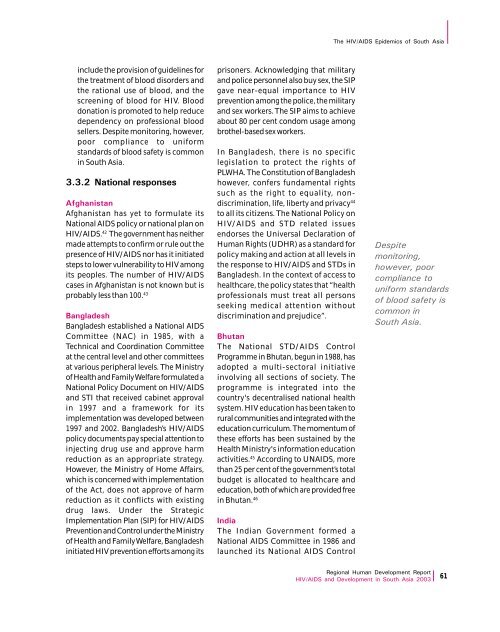Download Report - UNDP Asia-Pacific Regional Centre - United ...
Download Report - UNDP Asia-Pacific Regional Centre - United ...
Download Report - UNDP Asia-Pacific Regional Centre - United ...
You also want an ePaper? Increase the reach of your titles
YUMPU automatically turns print PDFs into web optimized ePapers that Google loves.
The HIV/AIDS Epidemics of South <strong>Asia</strong>include the provision of guidelines forthe treatment of blood disorders andthe rational use of blood, and thescreening of blood for HIV. Blooddonation is promoted to help reducedependency on professional bloodsellers. Despite monitoring, however,poor compliance to uniformstandards of blood safety is commonin South <strong>Asia</strong>.3.3.2 National responsesAfghanistanAfghanistan has yet to formulate itsNational AIDS policy or national plan onHIV/AIDS. 42 The government has neithermade attempts to confirm or rule out thepresence of HIV/AIDS nor has it initiatedsteps to lower vulnerability to HIV amongits peoples. The number of HIV/AIDScases in Afghanistan is not known but isprobably less than 100. 43BangladeshBangladesh established a National AIDSCommittee (NAC) in 1985, with aTechnical and Coordination Committeeat the central level and other committeesat various peripheral levels. The Ministryof Health and Family Welfare formulated aNational Policy Document on HIV/AIDSand STI that received cabinet approvalin 1997 and a framework for itsimplementation was developed between1997 and 2002. Bangladesh’s HIV/AIDSpolicy documents pay special attention toinjecting drug use and approve harmreduction as an appropriate strategy.However, the Ministry of Home Affairs,which is concerned with implementationof the Act, does not approve of harmreduction as it conflicts with existingdrug laws. Under the StrategicImplementation Plan (SIP) for HIV/AIDSPrevention and Control under the Ministryof Health and Family Welfare, Bangladeshinitiated HIV prevention efforts among itsprisoners. Acknowledging that militaryand police personnel also buy sex, the SIPgave near-equal importance to HIVprevention among the police, the militaryand sex workers. The SIP aims to achieveabout 80 per cent condom usage amongbrothel-based sex workers.In Bangladesh, there is no specificlegislation to protect the rights ofPLWHA. The Constitution of Bangladeshhowever, confers fundamental rightssuch as the right to equality, nondiscrimination,life, liberty and privacy 44to all its citizens. The National Policy onHIV/AIDS and STD related issuesendorses the Universal Declaration ofHuman Rights (UDHR) as a standard forpolicy making and action at all levels inthe response to HIV/AIDS and STDs inBangladesh. In the context of access tohealthcare, the policy states that “healthprofessionals must treat all personsseeking medical attention withoutdiscrimination and prejudice”.BhutanThe National STD/AIDS ControlProgramme in Bhutan, begun in 1988, hasadopted a multi-sectoral initiativeinvolving all sections of society. Theprogramme is integrated into thecountry's decentralised national healthsystem. HIV education has been taken torural communities and integrated with theeducation curriculum. The momentum ofthese efforts has been sustained by theHealth Ministry's information educationactivities. 45 According to UNAIDS, morethan 25 per cent of the government’s totalbudget is allocated to healthcare andeducation, both of which are provided freein Bhutan. 46IndiaThe Indian Government formed aNational AIDS Committee in 1986 andlaunched its National AIDS ControlDespitemonitoring,however, poorcompliance touniform standardsof blood safety iscommon inSouth <strong>Asia</strong>.<strong>Regional</strong> Human Development <strong>Report</strong>HIV/AIDS and Development in South <strong>Asia</strong> 2003 61
















